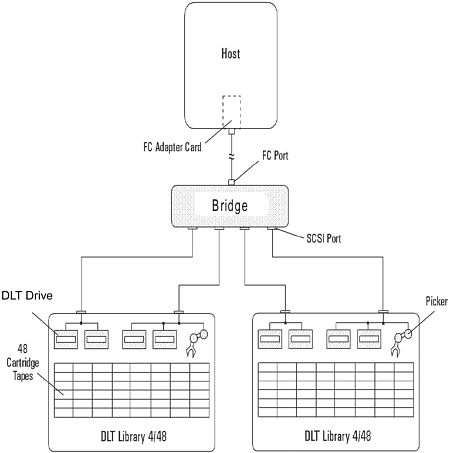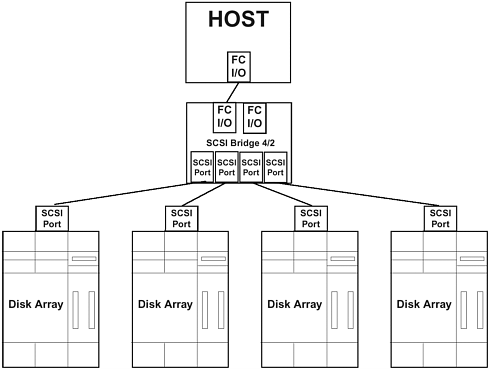8.6 SureStore E SCSI FC-SCSI FC 42 Bridge
| only for RuBoard - do not distribute or recompile |
8.6 SureStore E SCSI FC-SCSI FC 4/2 Bridge
Figure 8-25. FC-SCSI 4/2 Bridge

Most data centers today are using SCSI technology. Peripheral devices are attached to their host systems through SCSI cables connected to SCSI host bus adapters (HBAs). To use Fibre Channel technology, however, each system must be able to speak Fibre Channel. Meeting this requirement usually means expensive purchases and time-consuming conversion, migration of data, and installation of Fibre Channel-compatible hardware systems and peripherals.
Hewlett-Packard s solution to this concern is the SureStore E FC-SCSI Bridge 4/2. The bridge allows a Fibre Channel host to transmit data to SCSI devices. Using the bridge, customers can extend the distance between a host and peripherals and expand the number of SCSI devices connected to the host.
The bridge multiplexes the inputs and outputs from a single Fibre Channel connection to as many as four SCSI buses. Since each bus can support up to 15 devices, one bridge, theoretically, can support up to 60 devices (with varying levels of performance).
The advantage this device affords is to be able to attach existing SCSI devices to a Fibre Channel mass storage network.
8.6.1 Bridge Topologies
The bridge acts as a pass-through device that receives and transmits Fibre Channel packets. The host passes packets to SCSI devices as if the bridge were just another device along the path . Figure 8-26 shows a typical connection of two DLT tape libraries to a host.
Figure 8-26. Bridge Topology with Two DLT Libraries

The product takes advantage of Fibre Channel s ability to encapsulate SCSI protocol to allow a host with an FC host bus adapter to access SCSI peripheral devices transparently over a Fibre Channel connection.
Figure 8-27 shows a host attached to four SCSI disk arrays.
Figure 8-27. Bridge Topology with Four SCSI Disk Arrays

Another topology can be developed by adding a hub between the host and the bridge. This topology will allow an increased distance between the host and the target devices over that of the distance afforded by just incorporating a bridge.
For example, the distance from the host to a bridge can be up to 500 meters. Then the distance from the bridge to the SCSI devices can be up to 25 meters. However, by inserting a hub between the host and the bridge, an additional 500 meters can be added to the total distance.
Figure 8-28 shows a hub attached to a bridge.
Figure 8-28. Example of a Bridge Topology with a Hub

| only for RuBoard - do not distribute or recompile |
EAN: 2147483647
Pages: 88